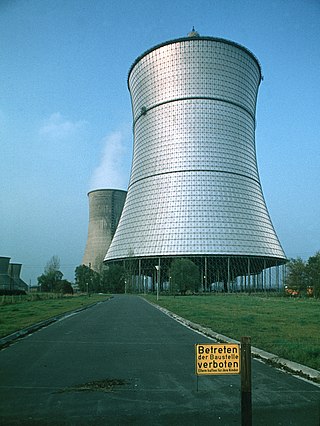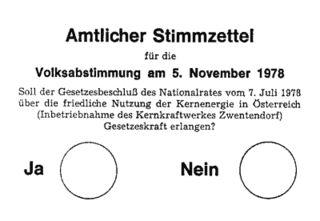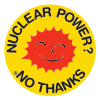
Zwentendorf an der Donau is a small market municipality in the Austrian state of Lower Austria. It is located at 48°21′N15°54′E, in the Tulln Basin on the southern bank of the Danube. The place attained public attention as the site of the only Austrian nuclear power station, which was completed but never went into operation. In a referendum on 5 November 1978, a narrow majority of 50.5% voted against putting the Zwentendorf nuclear plant into operation.

A nuclear power phase-out is the discontinuation of usage of nuclear power for energy production. Often initiated because of concerns about nuclear power, phase-outs usually include shutting down nuclear power plants and looking towards fossil fuels and renewable energy. Three nuclear accidents have influenced the discontinuation of nuclear power: the 1979 Three Mile Island partial nuclear meltdown in the United States, the 1986 Chernobyl disaster in the USSR, and the 2011 Fukushima nuclear disaster in Japan.

The THTR-300 was a thorium cycle high-temperature nuclear reactor rated at 300 MW electric (THTR-300) in Hamm-Uentrop, Germany. It started operating in 1983, synchronized with the grid in 1985, operated at full power in February 1987 and was shut down September 1, 1989. The THTR-300 served as a prototype high-temperature reactor (HTR) to use the TRISO pebble fuel produced by the AVR, an experimental pebble bed operated by VEW. The THTR-300 cost €2.05 billion and was predicted to cost an additional €425 million through December 2009 in decommissioning and other associated costs. The German state of North Rhine Westphalia, Federal Republic of Germany, and Hochtemperatur-Kernkraftwerk GmbH (HKG) financed the THTR-300’s construction.

The Lungmen Nuclear Power Plant, formerly known as Gongliao and commonly as the Fourth Nuclear Power Plant, is an unfinished nuclear power plant in New Taipei City, Taiwan. It consists of two ABWRs each of 1,300 MWe net. It is owned by Taiwan Power Company (Taipower).

Nuclear power plants operate in 32 countries and generate about a tenth of the world's electricity. Most are in Europe, North America, East Asia and South Asia. The United States is the largest producer of nuclear power, while France has the largest share of electricity generated by nuclear power, at about 70%. China has the fastest growing nuclear power programme with 16 new reactors under construction, followed by India, which has 8 under construction.

The Krško Nuclear Power Plant is located in Vrbina in the City Municipality of Krško, Slovenia. The plant was connected to the power grid on October 2, 1981, and went into commercial operation on January 15, 1983. It was built as a joint venture by Slovenia and Croatia which were at the time both part of Yugoslavia.

The Dürnrohr power station is a thermal power station in Lower Austria.

The Brunsbüttel Nuclear Power Plant is a nuclear power plant in Brunsbüttel near Hamburg, Germany. It is owned 67% by Vattenfall and 33% by E.ON. It started operation in 1976 and has a gross power production of 806 MW. During its lifetime, it produced 130,000 GW hours of electricity. The value of this electricity is about 9.1 billion Euros before calculation of the nuclear waste management.

The Grafenrheinfeld nuclear power plant is a now-offline electricity-generating facility near Grafenrheinfeld, south of Schweinfurt at the river Main. The plant operated from 1981 to June 28, 2015, when it was taken offline as part of the phase out policy for nuclear power in Germany. As a result of the plant's closure, Germany has relied heavily on coal and natural gas, primarily from Russia, to generate electricity.

The Leibstadt Nuclear Power Plant is located near Leibstadt, canton of Aargau, Switzerland, on the Rhine River and close to the border to Germany. Commissioned in 1984, it is the youngest and most powerful of the country's four operating reactors.
Nuclear power in Taiwan accounts for 2,945 MWe of capacity by means of 1 active plants and 2 reactors. In 2015, before the closure of 3 reactors, they made up around 8.1% of its national primary energy consumption, and 19% of its electricity generation. The technology chosen for the reactors has been General Electric BWR technology for 2 plants and Westinghouse PWR technology for the Maanshan Nuclear Power Plant. Construction of the Lungmen Nuclear Power Plant using the ABWR design has encountered public opposition and a host of delays, and in April 2014 the government decided to suspend construction.

Freda Meissner-Blau was an Austrian politician, activist, and prominent figurehead in the Austrian environmental movement. She was a founder and the federal spokesperson of the Austrian Green Party.
Hildegard Breiner is from Vorarlberg, Austria, where she and her late husband led the anti-nuclear campaign against Zwentendorf Nuclear Power Plant in the 1970s. In 1978, an unprecedented 85 percent of the voters in Vorarlberg cast their votes against Zwentendorf, tipping the scales of the nationwide referendum. In the second half of the 1980s, Hildegard Breiner played a major role in opposition to the nuclear reprocessing plant Wackersdorf to be built at Wackersdorf in neighbouring Bavaria, Germany. In 2004, Hildegard Breiner received the Nuclear-Free Future Lifetime Achievement Award.
Nuclear power in the European Union accounted for approximately 26% of total electricity production in 2019 and nearly half of low-carbon energy production across the EU.
In 2008, nuclear energy provided Switzerland with 40 percent of its electricity, but a survey of Swiss people found that only seven percent of respondents were totally in favor of energy production by nuclear power stations. Many large anti-nuclear demonstrations and protests have occurred over the years.

The Zwentendorf Nuclear Power Plant was the first commercial nuclear plant for electric power generation built in Austria, of 3 nuclear plants originally envisioned. Construction of the plant at Zwentendorf, Austria was finished but the plant never entered service. The start-up of the Zwentendorf plant, as well as the construction of the other 2 plants, was prevented by a referendum on 5 November 1978, in which a narrow majority of 50.47% voted against the start-up.

In the 1960s the Austrian government started a nuclear energy program and parliament unanimously ordered a nuclear power plant built. In 1972, the German company KWU began construction of the Zwentendorf Nuclear Power Plant boiling water 700 MWe reactor. In 1976, two years prior to the nuclear power plant opening, the government began a program to educate its citizens on the benefits and safety of nuclear power. However, this campaign began a public discussion that led to large demonstrations against the Zwentendorf plant in 1977.

A referendum on the use of nuclear power was held in Austria on 5 November 1978. Voters were asked whether they approved a law allowing the peaceful use of nuclear power, particularly relating to the start-up of the Zwentendorf Nuclear Power Plant. Voters narrowly rejected it, with 50.5% voting against. As a result, although the Power Plant was finished, it never operated and has been repurposed for various projects over the years.

As of the end of 2022, solar power in Austria amounted to nearly 3.8 gigawatt (GW) of cumulative photovoltaic (PV) capacity, with the energy source producing 4.2% of the nation's electricity.

The Occupation of the Hainburger Au wetlands in December 1984 marked a turning point for environmental awareness in German speaking central Europe and was of great significance for the development of democratic processes in Austria.

















